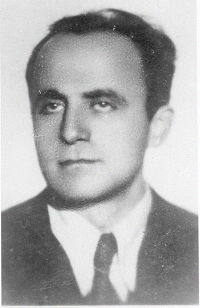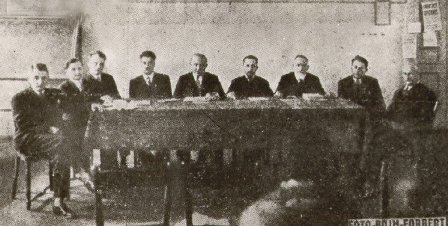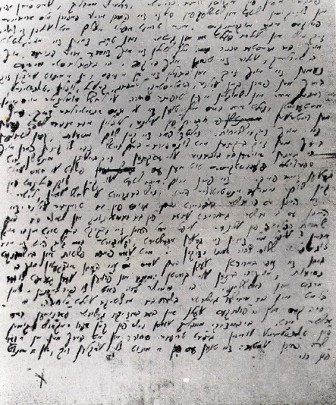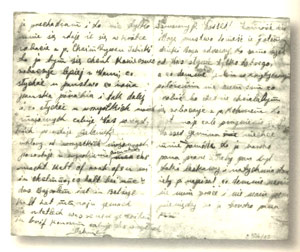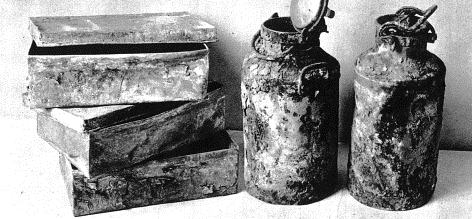Holocaust Education & Archive Research Team |
Ghettos
Introduction to the Ghettos of the Holocaust
Jewish Ghettos The Judenrat Judenrat Leaders Prominent Jews
| |||||
Emanuel Ringelblum The Creator of “Oneg Shabbat”
Emanuel Ringelblum was born in 1900 in Buczacz, which is situated near Stanislawow. He graduated from Warsaw University, after being awarded a doctorate in 1927 for his thesis on the history of the Jews of Warsaw during the Middle Ages.
For several years he taught history in Jewish schools and was also active in public affairs. From an early age he was also an active member of the political movement the “Left Po’alei Zion”, led by a core of devoted activists including Adolf Berman, and Emanuel Ringleblum himself.
In 1930 he had become a part-time employee of the Joint Distribution Committee (known as “The Joint”) and in November 1938 was sent by them to the Zbaszyn camp where 6,000 Jews – Polish citizens expelled from Germany – were gathered.
Ringelblum spent five weeks at the camp, where he directed relief work, collected testimonies from the deported Jews and gathered information on events in the Nazi Reich.
His experiences during this period left an indelible impression. In the early stages of the German attack on Warsaw during September 1939, Ringelblum participated in the activities of the coordinating committee of Jewish aid organisations.
Later when the Jewish Self-Help evolved from this committee, Ringelblum headed the department dedicated to the promotion of mutual assistance, including help for the needy and shelter to the Jews who came to Warsaw and those whose homes had been destroyed.
He was responsible for a network of soup kitchens serving tens of thousands of soup portions to the impoverished inhabitants of the ghetto. He also organised the so-called “House Committees” which were to play a vital role in the survival strategy.
In addition to these important activities, Ringelblum worked with the political underground, particularly the sector devoted to cultural affairs. Remarkably Ringelblum also found time for the two projects for which he is best remembered today. These were the Oneg Shabbat Archive and his personal chronicle of events.
Oneg Shabbat is Hebrew for “Sabbath delight”, a reference to the traditional Sabbath afternoon gathering for study and discussion. The code name Oneg Shabbat was used because those responsible for maintaining the archive held their secret meetings on the Sabbath
Ringelblum recorded the manner in which the archives evolved and their purpose:
“I began to collect material on current events in October 1939. As head of the Jewish Self-Help welfare organisation I had daily personal contact with the life around me. Information reached me on everything that happened to Jews in Warsaw or the suburbs.
The Coordinating Committee was at that time a branch of “The Joint” , and delegations from the smaller towns arrived almost daily to describe the difficulties experienced by the Jewish population.
Whatever I heard in the course of a day I wrote down in the evening, and added my observations. In time these daily records made up a good-sized book of some hundreds of closely written pages, a mirror of that time.
The daily records were replaced first by weekly summaries and later monthly summaries. I did this at a time when the number of colleagues working for the “Oneg Shabbat” had already become larger.
In May 1940 I decided that it would be proper to find wider support for this important work , I made a careful choice of people for the job and as a result the work progressed in the right direction and could be carried out in sufficient measure.
The secretary of “Oneg Shabbat” Hersz Wasser was appointed by the Committee of “Oneg Shabbat” at that time and he has continued with the work to the present day.
The creation of the ghetto, and the shutting away of the Jews within the walls, brought about even greater opportunities for work on the archives.
We reached the conclusion that the Germans took very little interest in what the Jews were doing amongst themselves. There were meetings on subjects and in a manner that would not have been possible before the war. One said everything that came to mind at every meeting of a house committee, in every soup kitchen and on the premises of every public institution, without interference.
The Jewish Gestapo agents were busy looking for the rich Jews with hoarded goods, smugglers etc. Politics interested them little. It went so far that illegal publications of all political directions appeared almost openly. In the cafes they were read practically in public, money was collected for the newspaper fund, there were arguments with opponents – in a word, people behaved almost like before the war.
In conditions of such “freedom” among the slaves of the ghetto it was not surprising that the work of “Oneg Shabbat” could develop successfully.”
Ringelblum was behind the creation of the Archives, and was the moving spirit behind its continued completion.Hersz Wasser the only surviving member of the “Oneg Shabbat” group recorded: “Every item, every article, be it long or short, had to pass through Dr Ringelblum’s hands. For weeks and months he spent the nights poring over the manuscripts, adding his comments and instructions.
The co-workers of the Archives were considered soldiers of the underground army. It is not surprising that the secret archive was appreciated by the fighting ghetto. The Board of Directors was expanded to include a host of prominent personalities and representatives of the various political factions and youth movements which included Emanuel Ringelblum, M. Kahan, Eliyahu Gutkowski, Rabbi Szymon Huberband , Hirsch Wasser, Abraham Lewin, Shakhne Sagan, Yitzhak Gitterman, Alexander Landau, David Guzik and Shmuel Breslaw.
The Archive members established the press department for the Jewish Fighting Organisation and for editors of underground newsletters both in the ghetto and on the “Aryan” side.
The Archive was to grow to enormous proportions – by early 1942 so much material had been gathered that it was decided to create a project with the title “Two and a Half Years” representing the period from September 1939, when the Germans occupied Poland.
A book of some 2,000 pages was produced divided into four sections:
1. General 2. Economic 3. Cultural – Scientific – Literary – Artistic 4. Social Welfare
Also included in the Archive were underground newspapers and posters published by different political parties, letters received in the ghetto considered to be of interest, minutes of meetings, reports on the activities of Jewish public organisations and the testimonies of Jews from other ghettos or labour camps arriving in Warsaw, the Archive sponsored papers on many other subjects.
The other subjects included the role of Jewish women in the war, children and youth in the ghetto, health issues, welfare and self-help, humour and folklore, relations between Poles and Jews, relations between the Germans and the Jews, education, cultural activities, religious affairs, the theatre in the ghetto, political and underground organisations, the smuggling of food and the secret economy.
It was intended to include as many German documents as possible in the Archive concerning the deportation and murder of Jews, not only from Warsaw but also from other towns and cities.
In January 1942 a Jewish man Szlamek Bajler – also known as Yakov Grojanowski – escaped from the Chelmno death camp via the Rabbi at Grabow to the Warsaw Ghetto. Szlamek provided the first eye-witness report about Chelmno to Ringelblum and Wasser.
Because the Gestapo was looking for Bajler, Ringelblum sent him to the Zamosc Ghetto where Bajler’s sister-in-law lived. When the first deportations to Belzec started, Bajler sent postcards to Ringelblum and Wasser in which he provided information about Belzec. He wrote in a combination of Polish and in Yiddish using Polish lettering.
“In Belzec iz Beit Olam wie in Chelmno” (“In Belzec there is a cemetery – literally “Home of Eternity” as in Chelmno.” Bajler was the first person to officially inform Ringelblum about the Belzec death camp – during the first “Aktion” in Zamosc on 14 April 1942 Bajler was deported to Belzec together with his sister-in –law.
The son of Szlamek’s sister-in –law sent a message to Wasser confirming their deportation.
The “Oneg Shabbat” Archive also published an informative newsletter, which first appeared at the beginning of 1942, to inform the Jews in the Warsaw ghetto of the mass-murder campaigns, Wasser relates:
“The leadership of the underground in the ghetto charged the “Oneg Shabbat” with the task of preparing various memoranda for consumption abroad – on the death camp at Chelmno (March 1942) on the Aktion in Lublin(April 1942) on the state of the Jewish population in the Nazi-occupied area (July 1942) and later on, in November 1942, the first exhaustive description of the initial stage of the liquidation of Warsaw Jewry. The editing of these works was placed in the hands of Dr. E. Ringelblum, A. Gutowski, and H.Wasser.”
During the deportations, which continued from July 1942 until May 1943, when the ghetto was liquidated, the small staff of devoted workers took pains to hide the invaluable material in secure places.
The collection was sealed inside metal containers and milk cans and buried within the ghetto in August 1942 and in March and April 1943.
On 3 August 1942 a schoolteacher and archivist Izrael Lichtensztajn assisted by two of his former pupils Dawid Graber and Nachum Grzybacz buried ten metal boxes and milk cans at 68 Nowolipki Street – 19 year old Dawid Graber wrote a note and place it in the interred archive, it read:
“The men who buried the archives know that they might not survive to see the moment when the treasure is dug up and the whole truth proclaimed.
What we were unable to scream out to the world, we have concealed under the ground. One thing I am proud of, namely in these disastrous and horrible days I had been chosen to help bury the treasure, in order that you may know of the tortures and murders of the Nazi tyrants.
"Blessed be those whom fate saved from suffering.” These were prophetic words- all those who buried the archives did not survive.
The first section of the Archive was recovered on 18 September 1946, the second part was found on 1 December 1950. A third part, which included material on the organisation and activities of the Jewish underground has never been found and is presumed to be lost forever. It is probable other containers concealed in the former ghetto are also lost forever.
Of the two parts of the archive that were recovered, the first contains 1,505 files and the second 558 files. Each file consists of as many as a dozen documents, varying in length from a single page to works of many pages. The first part comprises of 20,740 pages, the second part consists of 7,906 pages. Some pages were written in Polish, others in Yiddish, Hebrew or German. Also included were several dozen photographs, as well as paintings and drawings, and the diaries and notes of Ringelblum, Abraham Lewin, Peretz Opoczynski, Shimon Huberband and others.
The surviving Oneg Shabbat Archive is in the Zydowski Instytut Historyczny ( ZIH Jewish Historical Institute) in Warsaw, and it represents the most important source for the history of Polish Jewry during the war and the holocaust.
It was created through the foresight, courage and devotion of an unknown number of individuals, but perhaps most of all through the tireless work of its founder and guiding light Emanuel Ringelblum.
Returning to Emanuel Ringelblum his subsequent fate was tragic. He had repeatedly been invited to hide on the “Ayran” part of Warsaw and in March 1943, together with his wife Yehudit and 13-year old son Uri, they sought shelter on the “Aryan” part of Warsaw.
On the eve of Passover 1943 he returned to the ghetto alone, just as the uprising was commencing. What happened to Ringelblum during the uprising is not known, but in July 1943 he was discovered in the labour camp at Trawniki, by two members of the underground, who managed to extricate him from the camp and return him to Warsaw, disguised as a member of the Ostbahn (railway worker)
Together with his family and 38 other Jews, he hid in a bunker in “Aryan” Warsaw, but on 7 March 1944 the bunkers location was betrayed and the captives were taken to Pawiak Prison.
Another Jewish prisoner in Pawiak Julian Hirszhaut became involved in an attempt to remove Ringelblum from the condemned to death cells into those holding prisoners expected to be sent to Germany working as tailors and shoemakers.
Hirszhaut recalled how he managed to enter the cell where Ringelblum was being held:
“The cell was jammed with people apparently these were the Jews, whom the Germans had seized with Ringelblum in the bunker.
Ringelblum himself was sitting on a straw mattress close to the wall. On his lap he was holding a handsome boy. This was his son Uri. I told him that we were making attempts to take him in with us.
“And what will happen to him? He asked, pointing his finger at his son. “And what will happen to my wife, who is in the women’s section?”
What could I answer him?
We all knew well that if we succeeded in taking Ringelblum out of there and bringing him to us as a shoemaker or tailor, his family would still be doomed.
My silence conveyed the truth to him and he added right away: “Then I prefer to go the way of Kiddush Ha-Shem – The Sanctification of God’s Name together with them.
Later he told me how he had been tortured by the Gestapo. In the middle of our conversation he suddenly asked “Is death so hard to bear?”
And then, a little later, he went on with a voice broken by despair “What is the little boy guilty of?” – he again pointed at his son – “it breaks my heart to think of him.”
I stood helpless before Ringelblum – I did not know what to answer, and a wave of sorrow swept over my heart.” A few days later Ringelblum his family and the other Jews who had been captured in the bunker were executed in the ruins of the ghetto.
The person who had betrayed the location of the bunker, 18-year old Jan Lakinski was later sentenced to death by a tribunal in Warsaw.
Sources: Encyclopedia of the Holocaust Edited by Yisrael Guttman – published by MacMillan Publishing Company New York 1990 The Jews of Warsaw 1939 -1943 by Yisrael Gutman – published by The Harvester Press Ltd 1982 The Holocaust – The Jewish Tragedy by Sir Martin Gilbert – published by William Collins Sons and Co Ltd London 1986
Copyright: Carmelo Lisciotto & Chris Webb H.E.A.R.T 2007
|
